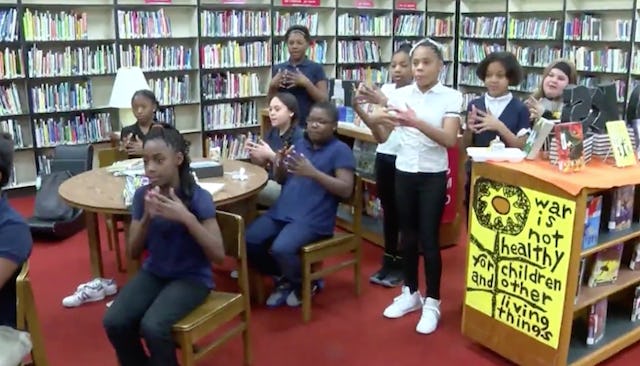5th Graders Use Recess Time To Learn Sign Language For Deaf Classmate

A group of kids started a sign language club to communicate with a deaf classmate
Recess is an important thing to kids in fifth grade, but for one group of Illinois students, it’s not nearly as important as learning to communicate with their deaf friend.
Rhemy Elsey is an 11-year-old who’s been deaf since birth, and he started attending Mark Bills School in Peoria, Illinois, this year. Rhemy has Cochlear implants that allow him to hear some sounds, but for talking, he mostly relies on sign language and is accompanied during his school day by interpreter Tammy Arvin.
When Rhemy started at Mark Bills, the majority of his classmates had never spent time around a deaf student. They wanted to be able to better communicate with their new friend, so they approached both Arvin and their school principal about starting an American Sign Language (ASL) club.
Image via WMBD
Image via WMBD
According to WMBD, the students have been meeting with Arvin every Wednesday during recess for the past four months so they can learn and practice new signs for Rhemy. Arvin teaches them common words and phrases, like “how are you,” but she also coordinates her lessons to whatever they’re studying in their regular classes. She says that, for her, one of the best parts has been seeing how eager the students are to learn.
“It can be really hard for [deaf kids] from a social and emotional standpoint to have an interpreter following them around all day long. It can feel somewhat isolating,” Arvin tells WMBD. “I was thrilled that they were interested and they wanted to learn some sign language and that they were taking some initiative to be able to communicate more effectively with one of their classmates.”
So far, ABC News reports the club members have learned basic signs for talking about school, food, and clothing. They love practicing what they’re learning with Rhemy and he says he feels “really happy” that his friends wanted to connect with him in this way. “It’s like they want to be like me,” he tells WMBD.
Of course, the most important part of the sign language club is the way it’s teaching Rhemy’s class about the deaf community. Without even realizing it, says Arvin, students are being exposed to “this other culture within the U.S. that they previously weren’t aware [of].” She says students are benefitting enormously, not only by learning a valuable skill, but also “in terms of learning about diversity and having a broader perspective on the world around them.”
With over a million people in the U.S. who are functionally deaf, it’s vitally important for kids to understand more about the deaf community and how to interact with their deaf peers. Learning sign language has brought these students closer together, taught them about acceptance and diversity, and given Rhemy a whole new level of independence at school. If you ask me, that’s even cooler than recess.